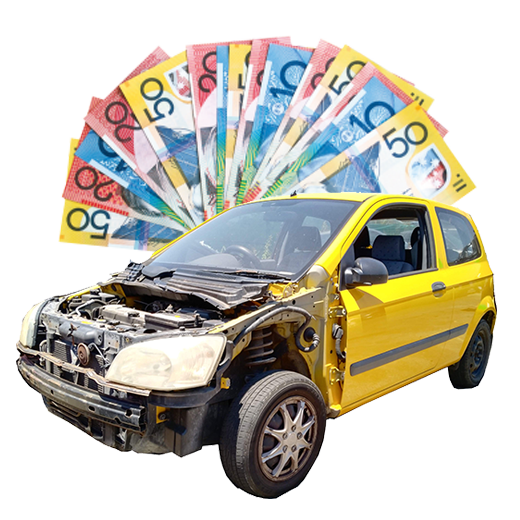The easiest and best way to get rid of old motor oil is to collect it in a leak-proof container and then drop it off at a designated collection point. You'll find that most local council facilities, and even auto parts stores like Supercheap Auto or Repco, have free oil recycling services set up specifically for people like us.
Why Proper Oil Disposal Is Non-Negotiable
Before we get into the nuts and bolts of how to do it, it’s worth taking a moment to understand why this is such a big deal. Tossing old oil in the bin or, even worse, pouring it down a drain isn't just a shortcut; it's a recipe for an environmental disaster. That used oil is full of nasty stuff like lead, arsenic, and cadmium that it picks up while running through your engine.
When that contaminated oil gets out into the environment, it causes some serious problems:
- Water Contamination: It’s a shocking fact, but just one litre of used motor oil can contaminate up to one million litres of fresh water. That makes it toxic for wildlife and completely unsafe for us.
- Soil Damage: If you pour oil onto the ground, it poisons the soil, stunts plant growth, and eventually seeps down, carrying those harmful chemicals into the groundwater.
- Harm to Ecosystems: Australia's unique wildlife is incredibly sensitive. Polluted water and soil can wreck local habitats, impacting everything from fish and birds to other native animals.
This infographic lays out the chain reaction pretty clearly.
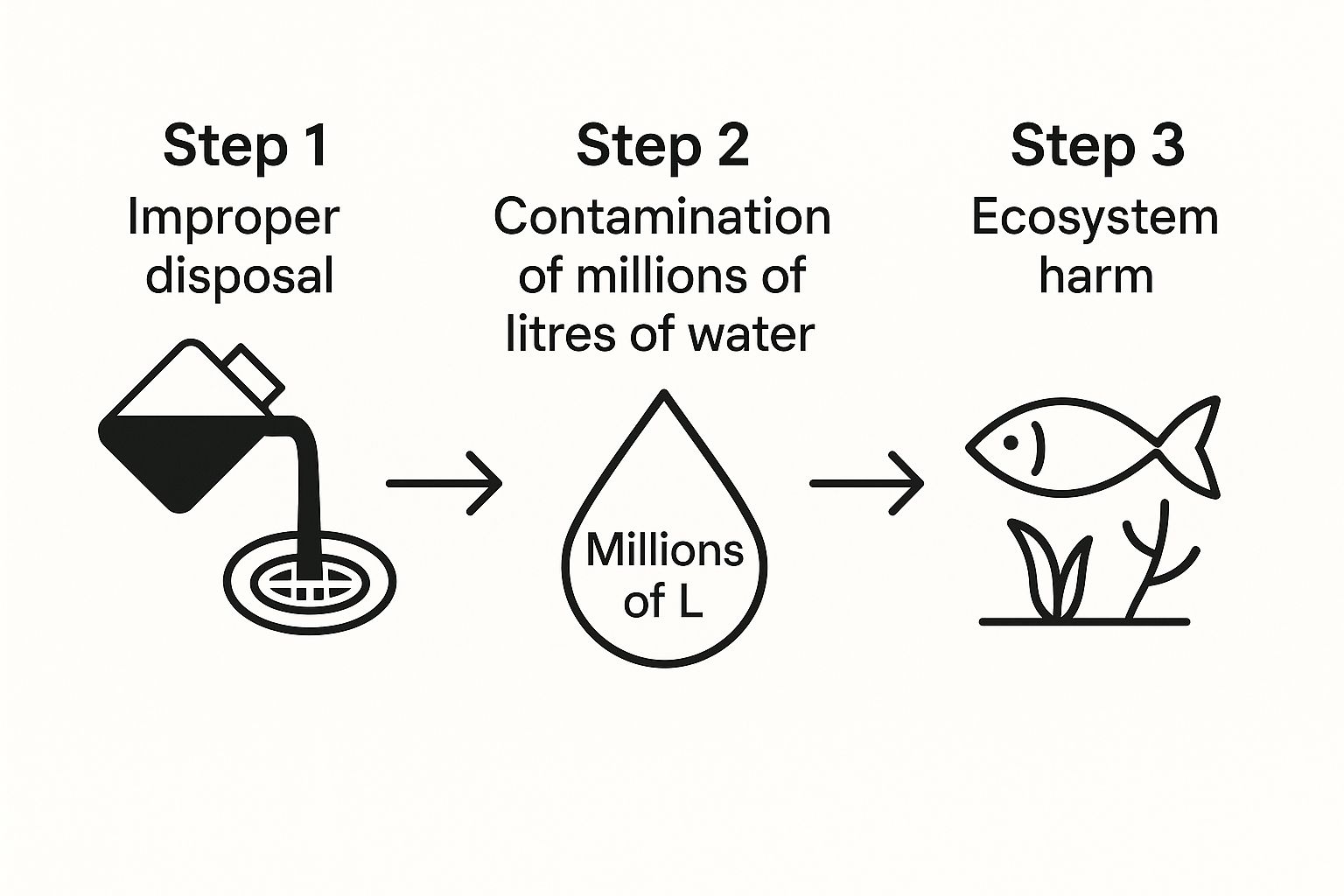
As you can see, one careless decision spirals into widespread environmental damage that’s incredibly difficult and expensive to fix.
The Scale of the Problem
The amount of used oil we're talking about is massive. While the numbers for Australia are significant, the waste oil market across the Asia-Pacific region was valued at an eye-watering USD 45.94 billion in 2025. This gives you a sense of the sheer volume of waste that needs to be managed responsibly.
This isn’t just about ticking a box or following a rule. It's about being a responsible car owner. Every time you do a DIY oil change, you also take on the duty of making sure that hazardous waste doesn't harm our environment.
At the end of the day, seeing the potential impact is the best reason to do things the right way. Proper disposal is a small effort that makes a huge difference to the health of our communities and the planet. For more detailed information, have a look at our guide on hazardous waste disposal.
Collecting and Storing Used Oil Like a Pro
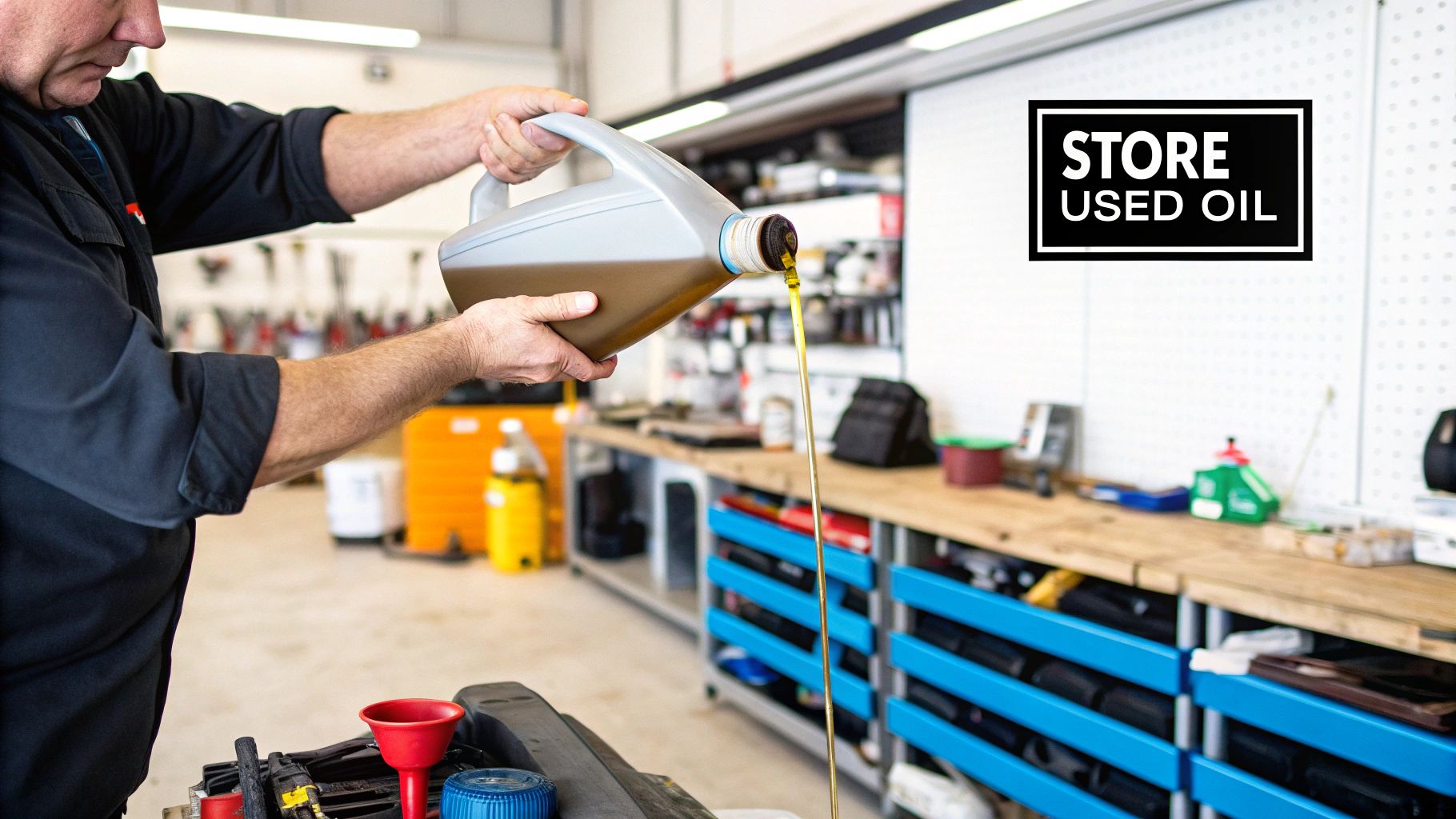
Before you can even think about getting rid of your old oil, you've got to collect it cleanly and store it safely. A messy job at this stage doesn't just mean a greasy cleanup in your garage; it can lead to spills that are genuinely harmful to the environment. Nailing this first part makes the whole disposal process a breeze.
Honestly, your best bet for a container is a simple, leak-proof one with a screw-on cap. You don’t need to buy anything special. The empty plastic bottle your new oil came in is perfect—it’s built for the job, it’s the right size, and you already have it. Just make sure it’s completely empty before you start pouring the old stuff in.
Choosing the Right Container
The container you pick is your first line of defence against leaks while you're storing the oil or driving it to the recycling centre. It might be tempting to grab an old milk carton, but trust me, they can easily split or degrade. The last thing you want is a black, greasy puddle in your car boot.
Here’s a quick rundown of what works and what absolutely doesn't:
- Best Options: The original motor oil bottle is the winner. Alternatively, a purpose-built oil drain container is a great investment if you do your own oil changes often. They’re made from oil-resistant plastic and have secure lids.
- Avoid at All Costs: Milk jugs, soft drink bottles, and especially glass jars. Also, steer clear of any container that once held chemicals like bleach, pesticides, or thinners.
The key is to keep the used oil pure. Never mix it with other fluids like antifreeze, brake fluid, or solvents. This contamination can make the oil unrecyclable, and the collection centre might refuse to take it.
Keeping it separate ensures it can be properly cleaned and re-refined.
Don't Forget the Oil Filter
It’s an easy thing to overlook, but your old oil filter is still full of used oil. After you unscrew it, it can hold a surprising amount—sometimes a couple of hundred millilitres! Taking the time to drain it properly is a must.
All you need to do is puncture the dome end of the filter with a screwdriver and place it upside down over your collection container. Let it drain for at least 12 hours (overnight is perfect). This gets as much oil out as possible and makes the filter much cleaner to handle.
Once it's drained, just pop the old filter into a sealed plastic bag to catch any last drips. Most collection points will happily take your used filters along with the oil, so you can get rid of everything in one trip.
Where to Take Your Used Motor Oil
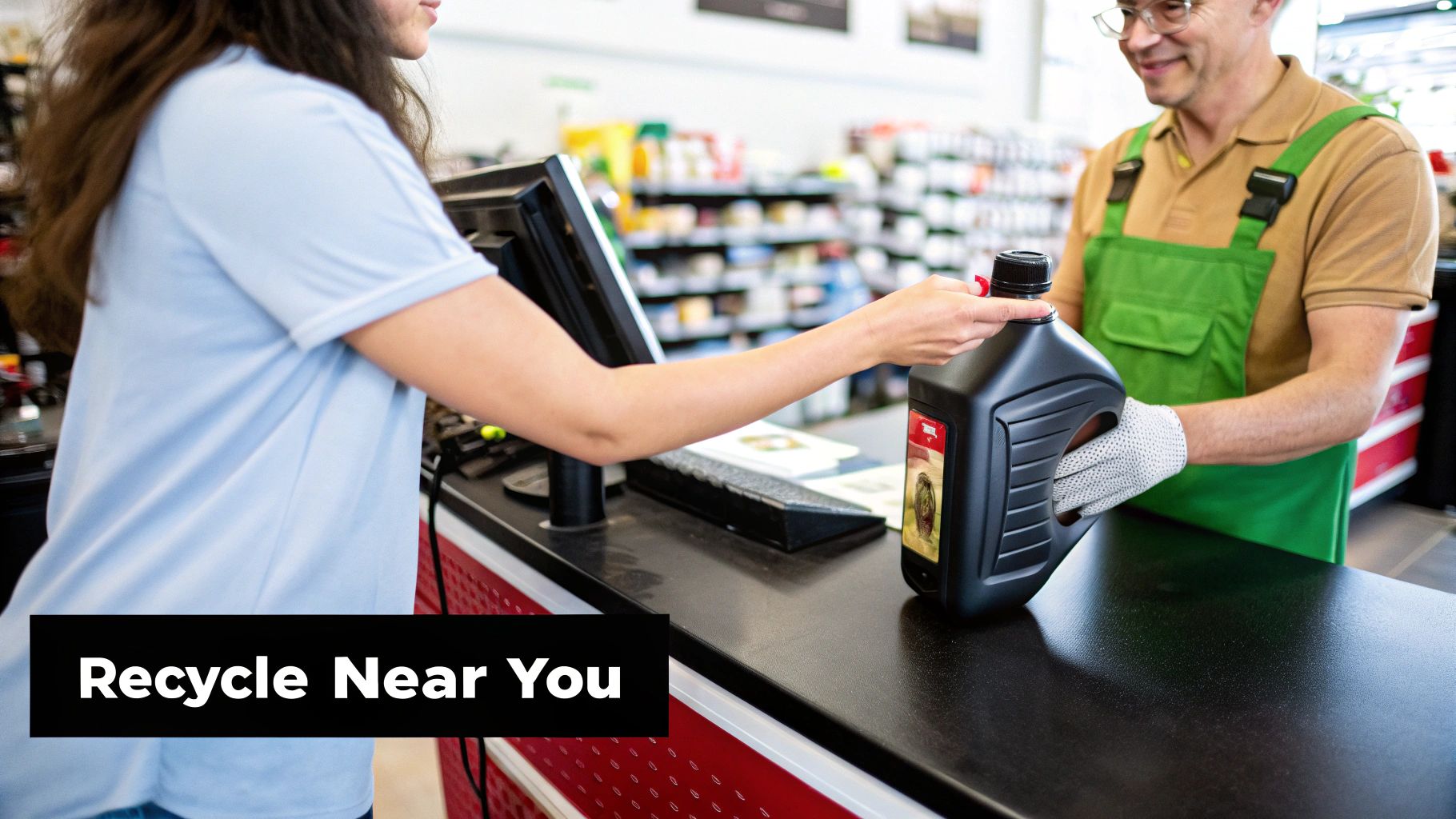
Alright, so you've got your used oil safely sealed and ready to go. The next question is, where do you take it? Thankfully, Australia has a pretty good network of free collection points, so you're never too far from a proper disposal spot. The days of being stuck with a container of old oil are long gone.
Finding a Drop-Off Point Near You
For most people, the local council tip or waste transfer station is the easiest option. They almost always have dedicated tanks just for used motor oil from residents. It's usually a free service for household quantities—we're talking up to about 20 litres per visit. It’s dead simple: you just drive in, locate the oil disposal area, and pour it into their collection tank.
What if the local tip isn't convenient? No worries. Many big auto parts retailers have really stepped up.
- Supercheap Auto and Repco: These guys are fantastic. Many of their stores will happily take your used motor oil. It’s a great system because you can drop off the old stuff when you're picking up filters and fresh oil for your next service.
- Local Mechanics: Don't forget about your friendly neighbourhood workshop. A lot of independent mechanics and service centres will take small amounts of used oil off your hands since they already have bulk collection services set up. Just give them a quick call first to check.
When in doubt, a quick search online will point you in the right direction.
I always recommend the Recycling Near You website, which is run by Planet Ark. It's an absolute gem. You just pop in your postcode, type "motor oil," and it shows you a map of all the closest accredited drop-off points.
This tool takes all the guesswork out of the process, making it incredibly easy to find out https://autoremovaladelaide.com.au/where-to-dispose-of-motor-oil/ no matter where you are in Australia.
To make things even clearer, here’s a quick rundown of your most common options.
Common Used Motor Oil Drop-Off Locations
| Location Type | Typical Availability | Key Considerations |
|---|---|---|
| Local Council Tips | Widespread, most councils | Free for residents. Check opening hours and quantity limits (usually 20L). |
| Auto Parts Retailers | Major chains (e.g., Repco) | Very convenient. Call ahead to confirm the specific store participates. |
| Mechanic Workshops | Many local garages | Best for small quantities. Always ask first, as it's at their discretion. |
| Hazardous Waste Events | Periodically by councils | Great for multiple hazardous items at once. Dates are infrequent. |
Finally, keep an eye on your local council's website or community newsletter. They often hold special hazardous waste collection days where you can get rid of tricky items like old oil, car batteries, and paint all in one go.
The Second Life of Your Used Motor Oil
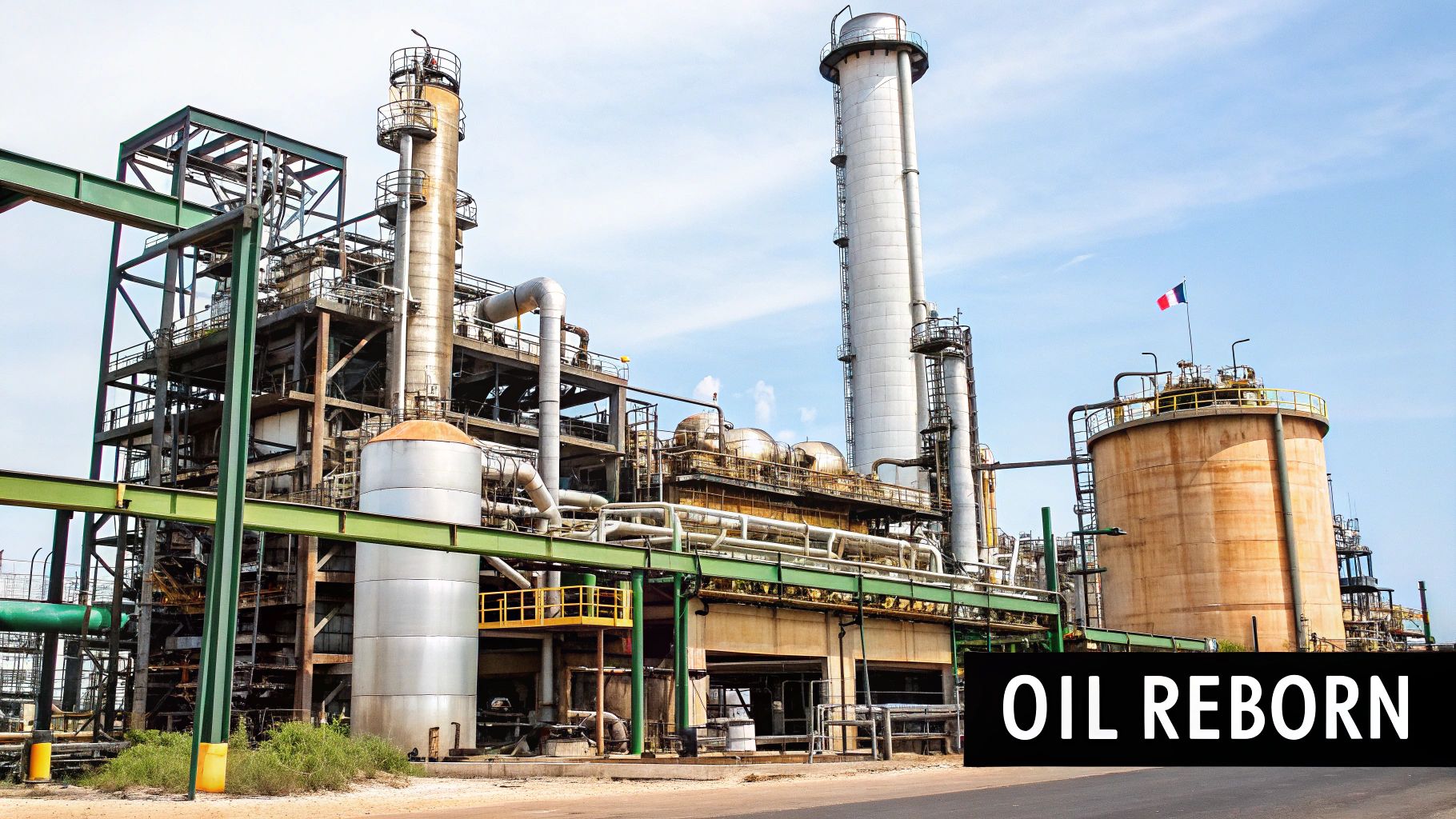
Ever wondered what actually happens after you drop off your used motor oil? It doesn't just vanish. Instead, it gets a new lease on life, becoming a valuable resource instead of a problematic waste product. Understanding this journey really highlights why your efforts matter so much.
The fascinating thing about motor oil is that it doesn’t really "wear out" – it just gets dirty. As it circulates through your engine, it picks up all sorts of gunk: tiny metal shavings, dirt, water, and chemical by-products. The recycling process, known as re-refining, is all about stripping those impurities away and getting the oil back to its pure, original state.
From Dirty Waste to Clean Base
The re-refining journey is a pretty clever one. It involves a multi-stage process of advanced filtering, heating, and chemical treatments that meticulously separate the pure base oil from all the grime it’s collected.
Once all the water, old additives, and contaminants have been removed, you're left with a high-quality base oil. This stuff is virtually identical to the "virgin" base oil that's refined from raw crude oil. From there, it’s ready to be blended with a fresh package of additives to become new engine lubricants, hydraulic fluids, and other top-tier products you'd find on a store shelf.
When you choose to dispose of motor oil correctly, you’re not just preventing pollution. You’re directly contributing to resource conservation by reducing the need to drill for new crude oil.
But that’s not its only potential second act. If it isn't re-refined, used oil can be processed into industrial burner fuel. This gives it another valuable purpose, providing an alternative energy source for power plants, cement kilns, and other heavy industrial facilities. Knowing the possibilities is a big part of understanding used oil recycling.
The push for better recycling is a global one. Projections show re-refining is expected to hold a 35.7% share of the waste oil market, but unfortunately, improper landfilling is still far too common. This is why the Australian government’s ‘Action Plan’ is so important, as it aims for an ambitious 80% recovery rate from all waste streams by 2030. It’s a clear national commitment to turning our waste back into a resource. You can dive deeper into waste oil market trends in this detailed analysis.
Common Questions About Motor Oil Disposal
https://www.youtube.com/embed/Se8-W7rK0H4
Even when you’ve got the basics of an oil change down, a few tricky questions always seem to pop up. Nailing these little details is just as important as the main event, making sure your disposal is clean, safe, and hassle-free. Let's get into some of the things people often ask.
Can I Mix Different Types of Oil for Disposal?
This is probably the number one question I get asked, and the answer is a hard no. You absolutely have to keep your used motor oil separate from other fluids. Don't be tempted to top up your used oil container with old coolant, brake fluid, or anything else from the garage.
Why does it matter so much? Because mixing in other chemicals contaminates the oil, making it completely useless for recycling. Collection centres are set up for pure motor oil, and if you hand them a chemical cocktail, they’ll almost certainly turn you away.
Pro Tip: Keep it simple and use one dedicated, clearly labelled container just for used engine oil. This one small habit makes all the difference and ensures the oil can actually be recycled.
Keeping the oil pure is the best way to do your part for the environment and give that oil a second chance at life.
How Much Used Oil Can I Drop Off at Once?
Wondering if you can rock up with a drum full of old oil? For us regular DIY folks in Australia, most council drop-off points and auto shops will happily take up to 20 litres per visit, completely free. That’s more than enough for a standard car or 4WD oil change.
That said, rules can differ slightly from one place to another. If you’ve saved up oil from a couple of services and have more than 20 litres, a quick phone call to the drop-off centre beforehand is a smart move. It’ll save you a potentially wasted trip.
Just remember, these free services are designed for household use. If you're running a workshop or generating commercial quantities of waste oil, you'll need to arrange for a proper commercial collection service.
What Do I Do with the Empty Oil Container?
Ah, the empty bottle dilemma. You've poured all the fresh oil into your engine, but what about the plastic container left behind? Even when it looks empty, that residue of oil means it can't just be tossed into your regular kerbside recycling.
The best thing to do is simply ask the staff where you're dropping off the old oil. Some specialised facilities are set up to recycle these oily containers, but many aren't. If they can’t take it, screw the lid on tight and put the container in your general waste bin.
Is It Okay to Store Used Oil Before Disposing of It?
Of course! There’s no need to make a special trip to the recycling centre every time you change your oil. It’s often much easier to store it for a few weeks or months until you've got a decent amount.
The most important thing here is storing it safely. Make sure it's in a sturdy, leak-proof container with the lid on tight and clearly marked "Used Motor Oil". Find a cool, dry spot for it—a garage shelf is perfect—well away from kids, pets, and direct sunlight. Waiting until the container is almost full just makes each drop-off run that much more efficient.
Do you have a broken, scrap, unused or unwanted car or truck sitting at home taking up space? Auto Removal Adelaide can help you get rid of it. We buy your junk car or truck and offer you up to $8,999 cash, with free scrap car removal included. Learn more at Auto Removal Adelaide.

